|
Havell Name
American White Pelican Common Name American White Pelican Havell Plate No. 311 Paper Size 39" x 28" Image Size 35" x 24" Price $ 1,700 |
||||
|
Ornithological Biography I feel great pleasure, good reader, in assuring you, that our White Pelican, which has hitherto been considered the same as that found in Europe, is quite different. In consequence of this discovery, I have honoured it with the name of my beloved country, over the mighty streams of which, may this splendid bird wander free and unmolested to the most distant times, as it has already done from the misty ages of unknown antiquity. In Dr. RICHARDSON\\\\\\\'s Introduction to the second volume of the Fauna Boreali-Americana, we are informed, that the Pelecanus Onocrotalus (which is the bird now named P. Americanus) flies in dense flocks all the summer in the Fur Countries. At page 472, the same intrepid traveller says, that \\\\\\\"Pelicans are numerous in the interior of the Fur Countries up to the sixty-first parallel; but they seldom come within two hundred miles of Hudson\\\\\\\'s Bay. They deposit their eggs usually on rocky islands, on the brink of cascades, where they can scarcely be approached; but they are otherwise by no means shy birds.\\\\\\\" My learned friend also speaks of the \\\\\\\"long thin bony process seen on the upper mandible of the bill of this species;\\\\\\\" and although neither he nor Mr. SWAINSON pointed out the actual differences otherwise existing between this and the European species, he states that no such appearance has been described as occurring on the bills of the White Pelicans of the old Continent. When, somewhat more than thirty years ago, I first removed to Kentucky, Pelicans of this species were frequently seen by me on the sand-bars of the Ohio, and on the rock-bound waters of the rapids of that majestic river, situated, as you well know, between Louisville and Shippingport. Nay when, a few years afterwards, I established myself at Henderson, the White Pelicans were so abundant that I often killed several at a shot, on a well known sand-bar, which protects Canoe Creek Island. During those delightful days of my early manhood, how often have I watched them with delight! Methinks indeed, reader, those days have returned to me, as if to enable me the better once more to read the scattered notes contained in my often-searched journals. Ranged along the margins of the sand-bar, in broken array, stand a hundred heavy-bodied Pelicans. Gorgeous tints, all autumnal, enrich the foliage of every tree around, the reflection of which, like fragments of the rainbow, seems to fill the very depths of the placid and almost sleeping waters of the Ohio. The subdued and ruddy beams of the orb of day assure me that the Indian summer has commenced, that happy season of unrivalled loveliness and serenity, symbolic of autumnal life, which to every enthusiastic lover of nature must be the purest and calmest period of his career. Pluming themselves, the gorged Pelicans patiently wait the return of hunger. Should one chance to gape, all, as if by sympathy, in succession open their long and broad mandibles, yawning lazily and ludicrously. Now, the whole length of their largest quills is passed through the bill, until at length their apparel is as beautifully trimmed as if the party were to figure at a route. But mark, the red beams of the setting sun tinge the tall tops of the forest trees; the birds experience the cravings of hunger, and to satisfy them they must now labour. Clumsily do they rise on their columnar legs, and heavily waddle to the water. But now, how changed do they seem! Lightly do they float, as they marshal themselves, and extend their line, and now their broad paddle-like feet propel them onwards. In yonder nook, the small fry are dancing in the quiet water, perhaps in their own manner bidding farewell to the orb of day, perhaps seeking something for their supper. Thousands there are, all gay, and the very manner of their mirth, causing the waters to sparkle, invites their foes to advance toward the shoal. And now the Pelicans, aware of the faculties of their scaly prey, at once spread out their broad wings, press closely forward with powerful strokes of their feet, drive the little fishes toward the shallow shore, and then, with their enormous pouches spread like so many bag-nets, scoop them out and devour them in thousands. How strange it is, reader, that birds of this species should be found breeding in the Fur Countries, at about the same period when they are to be found on the waters of the inland bays of the Mexican Gulf! On the 2nd of April, 1837, I met with these birds in abundance at the south-west entrance or mouth of the Mississippi, and afterwards saw them in the course of the same season, in almost every inlet, bay, or river, as I advanced toward Texas, where I found some of them in the Bay of Galveston, on the 1st of May. Nay, while on the Island of Grande Terre, I was assured by Mr. ANDRY, a sugar-planter, who has resided there for some years, that he had observed White Pelicans along the shores every month of the year. Can it be, that in this species of bird, as in many others, barren individuals should remain in sections of countries altogether forsaken by those which are reproductive? The latter, we know, travel to the Rocky Mountains and the Fur Countries of the north, and there breed. Or do some of these birds, as well as of certain species of our Ducks, remain and reproduce in those southern localities, induced to do so by some organic or instinctive peculiarity? Ah, reader, how little do we yet know of the wonderful combinations of Nature\\\\\\\'s arrangements, to render every individual of her creation comfortable and happy under all the circumstances in which they may be placed! My friend JOHN BACHMAN, in a note to me, says that \\\\\\\"this bird is now more rare on our coast than it was thirty years ago; for I have heard it stated that it formerly bred on the sand banks of our Bird Islands. I saw a flock on the Bird Banks off Bull\\\\\\\'s Island, on the 1st day of July, 1814, when I procured two full-plumaged old birds, and was under the impression that they had laid eggs on one of those banks, but the latter had the day previous to my visit been overflowed by a spring tide, accompanied with heavy wind.\\\\\\\" A single pair of our White Pelicans were procured not far from Philadelphia, on the Delaware or Schuylkill, ten or twelve years ago, and one or two have been shot on the upper waters of the Hudson. These were the only birds of this kind that, I believe, were ever observed in our Middle Districts, where even the Brown Pelican, Pelecanus fuscus, is never seen. From these facts, it may be concluded that the White Pelicans reach the Fur Countries of Hudson\\\\\\\'s Bay by inland journeys, and mostly by passing along our great western rivers in the spring months, as they are also wont to do, though with less rapid movements, in autumn. Reader, I have thought a thousand times perhaps that the present state of migration of many of our birds, is in a manner artificial, and that a portion of the myriads of Ducks, Geese, and other kinds, which leave our Southern Districts every spring for higher latitudes, were formerly in the habit of remaining and breeding in every section of the country that was found to be favourable for that purpose. It seems to me that it is now on account of the difficulties they meet with, from the constantly increasing numbers of our hostile species, that these creatures are urged to proceed towards wild and uninhabited parts of the world, where they find that security from molestation necessary to enable them to rear their innocent progeny, but which is now denied them in countries once their own. The White American Pelican never descends from on wing upon its prey, as is the habit of the Brown Pelican; and, although on many occasions it fishes in the manner above described, it varies its mode according to circumstances, such as a feeling of security, or the accidental meeting with shoals of fishes in such shallows as the birds can well compass. They never dive for their food, but only thrust their head into the waters as far as their neck can reach, and withdraw it as soon as they have caught something, or have missed it, for their head is seldom out of sight more than half a minute at a time. When they are upon rivers, they usually feed along the margin of the water, though, I believe, mostly in swimming depth, when they proceed with greater celerity than when on the sand. While thus swimming, you see their necks extended, with their upper mandible only above the water, the lower being laterally extended, and ready to receive whatever fish or other food may chance to come into the net-like apparatus attached to it. As this species is often seen alone, the sea shores searching for food, as well as on fresh water, I will give you a description of its manners there. While on the Island of Barataria in April 1837, I one afternoon observed a number of White Pelicans swimming against the wind and current, with their wings partially extended, and the neck stretched out, the upper mandible alone appearing above the surface, while the lower must have been used as a scoop-net, as I saw it raised from time to time, and brought to meet the upper, when the whole bill immediately fell to a perpendicular position, the water was allowed to run out, and the bill being again raised upwards, the fish was swallowed. After thus swimming for about a hundred yards in an extended line, and parallel to each other, they would rise on wing, wheel about, and realight at the place where their fishing had commenced, when they would repeat the same actions. I continued watching them more than an hour, concealed among a large quantity of drifted logs, until their fishing was finished, when they all flew off to the lee of another island, no doubt to spend the night there, for these birds are altogether diurnal. When gorged, they retire to the shores, to small islands in bays or rivers, or sit on logs floating in shallow water, at a good distance from the beach; in all which situations they are prone to lie down, or stand closely together. Being anxious, when on my last expedition, to procure several specimens of these birds for the purpose of presenting you with an account of their anatomical structure, I requested all on board our vessel to shoot them on all occasions; but no birds having been procured, I was obliged to set out with a \\\\\\\"select party\\\\\\\" for the purpose. Having heard some of the sailors say that large flocks of White Pelicans had been seen on the inner islets of Barataria Bay, within the island called Grande Terre, we had a boat manned, and my friend EDWARD HARRIS, my son, and myself, went off in search of them. After awhile we saw large flocks of these birds on some grounded logs, but found that it was no easy matter to get near them, on account of the shallowness of the bay, the water being scarcely two feet in depth for upwards of half a mile about us. Quietly, and with all possible care, we neared a flock; and strange it was for me to be once more within shooting distance of White Pelicans. It would no doubt be a very interesting sight to you, were you to mark the gravity and sedateness of some hundreds of these Pelicans, closely huddled together on a heap of stranded logs, or a small bank of racoon oysters. They were lying on their breasts, but as we neared them they all arose deliberately to their full height. Some, gently sliding from the logs, swam off towards the nearest flock, as unapprehensive of danger as if they had been a mile distant. But now their bright eyes were distinctly visible to us, our guns, charged with buckshot, were in readiness, and my son was lying in the bow of the boat waiting for the signal. \\\\\\\"Fire!\\\\\\\"--The report is instantly heard, the affrighted birds spread their wings and hurry away, leaving behind three of their companions floating on the water. Another shot from a different gun brought down a fourth from on wing; and as a few were scampering off wounded, we gave chase, and soon placed all our prizes in the after sheets. About a quarter of a mile farther on, we killed two, and pursued several that were severely wounded in the wing, but they escaped, for they swam off so rapidly that we could not propel our boat with sufficient speed to catch them amidst the tortuous shallows. The Pelicans appeared tame, if not almost stupid; and at one place, where there were about sixty on an immense log, could we have gone twenty yards nearer, we might have killed eight or ten at a single discharge. But we had already a full cargo, and therefore returned to the vessel, on the decks of which the wounded birds were allowed to roam at large. We found these Pelicans hard to kill, and some which were perforated with buckshot did not expire until eight or ten minutes after they were fired at. A wonderful instance of this tenacity of life was to be seen on board a schooner then at anchor in the harbour. A Pelican had been grazed on the hind part of the head with an ounce ball from a musket, and yet five days afterwards it was apparently convalescent, and had become quite gentle. When wounded, they swim rather sluggishly, and do not attempt to dive, or even to bite, like the Brown Pelicans, although they are twice as large, and proportionally stronger. After being shot at, they are perfectly silent, but when alighted they utter a hollow guttural sound somewhat resembling that produced by blowing through the bung-hole of a cask. The White Pelicans appear almost inactive during the greater part of the day, fishing only soon after sunrise, and again about an hour before sunset; though at times the whole flock will mount high in the air, and perform extended gyrations in the manner of the Hooping Crane, Wood Ibis, and Vultures. These movements are probably performed for the purpose of assisting their digestion, and of airing themselves, in the higher and cooler regions of the atmosphere. Whilst on the ground, they at times spread their wings to the breeze, or to the rays of the sun; but this act is much more rarely performed by them than by the Brown Pelicans. When walking, they seem exceedingly awkward, and like many cowardly individuals of our own species, are apt to snap at objects which they appear to know perfectly to be so far superior to them as to disdain taking notice of them. Their usual manner of flight is precisely similar to that of our Brown species. It is said by authors that the White Pelican can alight on trees; but I have never seen a single instance of its doing so. I am of opinion that the ridge projecting from the upper mandible increases in size as the bird grows older, and that it uses that apparatus as a means of defence or of attack, when engaged with its rivals in the love-season. The number of small fishes destroyed by a single bird of this species may appear to you, as it did to me, quite extraordinary. While I was at General HERNANDEZ\\\\\\\'s plantation in East Florida, one of them chanced to pass close over the house of my generous host, and was brought dead to the ground. It was not a mature bird, but apparently about eighteen months old. On opening it, we found in its stomach several hundreds of fishes, of the size of what are usually called minnows. Among the many which I have at different times examined, I never found one containing fishes as large as those commonly swallowed by the Brown species, which, in my opinion, is more likely to secure a large fish by plunging upon it from on wing, than a bird which must swim after its prey. This beautiful species,--for, reader, it is truly beautiful, and you would say so were you to pick it up in all the natural cleanness of its plumage, from the surface of the water,--carries its crest broadly expanded, as if divided into two parts from the centre of the head. The brightness of its eyes seemed to me to rival that of the purest diamond; and in the love-season, or the spring of the year, the orange-red colour of its legs and feet, as well as of the pouch and bill, is wonderfully enriched, being as represented in my plate, while during the autumnal months these parts are pale. Its flesh is rank, fishy, and nauseous, and therefore quite unfit for food, unless in cases of extreme necessity. The idea that these birds are easily caught when gorged with fish, is quite incorrect, for when approached, on such an occasion, they throw up their food, as Vultures are wont to do. I regret exceedingly that I cannot say any thing respecting their nests, eggs, or young, as I have not been in the countries in which they are said to breed. AMERICAN WHITE PELICAN, Pelecanus americanus, Aud. Orn. Biog., vol. iv.p. 88. Male, 61 3/4, 103; bill, 13 3/4. Common during winter from Texas to South Carolina, both along the coast and about the lakes and rivers adjoining the Missouri, Mississippi, and Ohio. Breeds from California northward to lat. 61 degrees. Accidental in the Middle Atlantic Districts. Adult Male. Bill a little more than thrice the length of the head, rather slender, almost straight, depressed. Upper mandible linear, depressed, convex at the base, gradually flattened and a little enlarged to near the end, when it again narrows, and terminates in a hooked point. The ridge is broad and convex at the base, becomes gradually narrowed and flattened beyond the middle, is elevated into a thin crest about an inch high, of a fibrous structure, and about three inches in length (in some specimens as much as five inches) which is continued forwards of less elevation to the extent of an inch farther. The ridge of the mandible is then narrow and flat, and terminates in the unguis, which is oblong, slightly carinate above, curved, obtuse, concave beneath. The edges are very sharp and a little involute; the lower surface of the mandible has a median slender sharp ridge, on each side of which, at the distance of a quarter of an inch, is a stronger ridge having a groove in its whole length; the sides then slope upwards to the incurved margin, and in this latter space is received the edge of the other mandible. Lower mandible having its crura separated, very slender, elastic, and meeting only at the very extremity, so that the angle or interspace may be described as extremely long, occupying in fact the whole length of the bill excepting four-twelfths of an inch at the end; for two-thirds of its length from the base, the lower mandible is broader than the upper, which is owing to the crura lying obliquely, but beyond the crest it is narrower; the extremely short dorsal line ascending, convex, the edges inflected, sharp, and longitudinally grooved. To the lower mandible, in place of the skin or membrane filling up the angle as in most other birds, is appended a vast sac seven inches in depth opposite the base of the bill, and extending down the throat about eight inches, so that its length from the tip of the lower mandible is twenty-one and a half inches. It is formed of the skin, which is thin, transparent, elastic, rugous, highly vascular, and capable of being expanded like a net, supported by the elastic mandibles to the breadth of nine and a half inches. Head small, oblong; neck long, stout; body full, rather flattened. Feet short and very stout; tibia bare at its lower part, covered all round with small scales; tarsus short, very stout, compressed, covered all round with hexagonal scales, of which the anterior are much larger; toes in the same plane, all connected by reticulated webs, the first shortest, the second an inch shorter than the fourth, which is considerably longer than the third, scaly at the base, scutellate over the rest of their extent. Claws short, strong, curved, rather blunt, that of the middle toe with a sharp pectinate inner edge. Feathers of the head and neck exceedingly small, slender, and of a downy texture, those on the fore part of the head a little more compact; on the nape they are elongated, acuminate, and form a longitudinal narrow crest, which runs down the back of the neck. The feathers in general are lanceolate, acuminate, and of moderately dense texture; those at the junction of the neck and breast anteriorly are stiffer and more elongated. Wings very long, rather narrow, rounded; the humerus and cubitus very long in proportion; primaries much curved; secondaries rather narrow, also incurved toward the end, the inner extending when the wing is closed far beyond the tips of the primaries. Tail short, broad, rounded, of twenty-four feathers, which are broad and abruptly acuminate. Bill bare, space about the eye, and feet, rich bright yellow, becoming brighter before their departure for their breeding grounds; claws yellowish-brown; tip of the bill brighter than the rest. Iris white, in younger birds dusky. The general colour of the plumage is pure white; the crest, the elongated feathers on the fore part of the breast, and those near the edge of the cubitus, pale yellow. The alula, primary coverts, and primary quills, black, the shafts white, becoming brownish-black toward the end. The inner ten secondaries are white, the rest black, more or less tipped with greyish-white, their bases white, that colour more extended on the inner than the outer, the shafts of all the quills white beneath, those of the secondaries tinged with grey. Dimensions of an old male. Length to end of tail 61 3/4 inches, to end of wing 61 3/4, to end of claws 66 3/4, from the point of the bill to the carpal joint 40; extent of wings 103; wing from flexure 24 1/2; length of cubitus 15; tail 6 1/4; bill along the ridge 13 3/4 along the edge of lower mandible 15; breadth of lower mandible at the base 2; bare part of tibia 1; tarsus 4 8/12; middle toe 4 1/2, its claw 5/8; outer toe 4 1/2, its claw 6/12; inner toe 3, its claw 7/12; hind toe 1 3/4, its claw 8/12. Weight 17 1/2 lbs. The Female is rather less, and in as far as I am warranted by the examination of several individuals in stating, is destitute of the horny crest of the upper mandible. A male, shot near Grande Terre, in the Gulf of Mexico, examined. The skin is very thin, but the subcutaneous cellular tissue is extremely developed, forming a thick reticular layer over the whole body. The internal cells are also of vast size, the right hepatic being 4 1/2 inches long, the right abdominal 4 1/2 by 4; the left abdominal 5 1/2 by 4; the clavicular cell is not formed by a single cavity, but of numberless cellules, like those of the subcutaneous tissue. The heart [n] [see Figure 1] is triangular, pointed, 3 inches long, 2 inches and 10 twelfths in breadth; the aorta branches at the base, as in other birds, sending off the two trunks which separate into the subclavian and carotid. The lobes of the liver are extremely unequal, the right, [o], being 4 inches in length, and 2 1/4 in breadth, while the left, [p], is only 2 inches long, and 1 1/4 inches broad. The mandibles are entirely covered with skin, of which the subcutaneous tissue is wanting, the cutis condensed, and the cuticle in large irregular longitudinal plates, leaving the surface somewhat rough and scaly. The crest-like excrescence on the ridge of the upper mandible is not formed of bone, nor otherwise connected with the osseous surface, which is smooth and continuous beneath it, than by being placed upon it, like any other part of the skin, and when softened by immersion in a liquid may be bent a little to either side. It is composed internally of erect slender plates of a fibrous texture, externally of horny fibres, which are erect on the sides, and longitudinal on the broadened ridge; these fibres being continuous with the cutis and cuticle. The skin of the mandible is continuous with that of the pouch, of which the structure is as follows: Externally there is a layer of cuticle, beneath which is the cutis, extremely thin, and with the cuticle thrown into longitudinal rugae when contracted. The internal surface is also of cuticle, and beneath it is a layer of cutis. Between these two very thin layers of skin, is interposed an equally thin layer, composed of two sets of very slender muscular fibres, separated from each other, and running in two opposite directions. The outer fibres run in fasciculi from the lower and inner edge of the mandible; those from its base pass downwards, those arising more anteriorly pass gradually more forwards, and spreading out, reach the middle line of the pouch. The inner fibres have the same origin, and pass in a contrary direction, backwards and inwards. From the hyoid bone to the junction of the two crura of the mandible, which takes place almost at the very tip, there extends a thin band of longitudinal muscular fibres, in the centre of which is a cord of elastic tissue. By means of this apparatus, the sac is contracted, so as to occupy little space. When the bill is opened, the crura of the lower mandible separate from each other to a considerable extent, by the action of the muscles inserted into their base, this depending upon their oblique position, and the sac is expanded. The upper mandible is capable of being moved to a considerable extent. Below the anterior angle of the eye is a small sac about 5 twelfths of an inch in length, with an external aperture of 2 twelfths, and filled with a pulpy substance. The nostrils are linear, about 3 twelfths of an inch long, and quite concealed by the wrinkles of the skin. The aperture of the posterior nares 8 twelfths. The tongue is an extremely small, papilliform body, 3 1/2 twelfths of an inch long, and 1 twelfth in diameter. The aperture of the glottis is linear, 8 twelfths in length, destitute of papillae behind. The pharynx is about 2 1/2 inches in breadth. The oesophagus Fig. 1[a], at the commencement, or opposite the tongue, has a diameter of about 6 inches, and contracts until the middle of the neck, where it is 3 inches in width; at its entrance into the thorax at [b] it contracts to 1 1/2 inches, but is dilatable to 3 inches; at this part, its inner coat is thrown into very prominent longitudinal rugae. The structure of the oesophagus is similar to that of the Loon already described, but its muscular coat is much thinner. On entering the thorax, it again expands to a diameter of 3 inches. Its length from the glottis, exclusive of the proventriculus, is 2 feet. The proventriculus, [c] [d], when not extended, has a diameter of 2 inches, its length being 4 inches and 8 twelfths. It is marked internally with six longitudinal broad ridges, about half an inch in breadth, and separated by grooves; and its cuticular lining is 1 1/2 twelfths thick, of a compact but soft texture, elevated into tortuous reticulated ridges. The glandules, which are cylindrical, the largest 3 twelfths of an inch long, 1/2 twelfth in diameter, form a complete elongated belt. The muscular coat is also very thick, its inner layer composed of transverse, its outer of longitudinal fibres, and the greatest thickness of the walls of the proventriculus is about 4 1/2 twelfths of an inch. The stomach, [e], properly so called, is extremely small, being of a roundish, compressed form, 1 1/4 inches in length, and of the same breadth; its muscular coat composed of slender fasciculi, and not presenting a distinction into lateral and inferior muscles, its inner coat smooth. Appended to it on the right side is a sac [f], of a roundish form, 1 9/12 inches in length, and 1 1/2 in breadth, joining it by a contraction, of which the diameter is 1/2 inch, and opening directly into the proventriculus, as well as into the stomach; its walls thin, its inner surface smooth, with numerous mucous crypts irregularly disposed. The pylorus, [g], is exceedingly small, 1 1/2 twelfths in diameter, with a thickened margin. The duodenum [g h i], passes backwards and upwards to the length of 6 1/2 inches, returns upon itself enclosing the pancreas, receives the biliary ducts at the distance of 14 inches from the pylorus. The gall-bladder is oblong, 2 inches long, and 10 twelfths broad. The intestine then forms numerous convolutions, [j k l], occupying the whole abdomen, and lying in part over the stomach and proventriculus. Its entire length is 10 feet 10 inches. Its diameter varies little, it being at the upper part 5 twelfths of an inch, towards the rectum 3 1/2 twelfths. The rectum is 5 1/2 inches long, including the cloaca, [m], which is globular, and about 2 1/2 inches in diameter. The coeca are 1 inch and 1 twelfth in length, 4 twelfths in diameter, cylindrical, rounded at the end. The muscular coat of the intestine is very strong, the inner villous. One of the testes is 1 inch long, the other 1 1/2; their form oblong. In the proventriculus and stomach is a vast accumulation of small lumbrici, about 1 1/4 inches in length, and amounting to about 1000. The trachea is 1 foot 10 inches long, a little flattened, 1/2 inch in diameter throughout, but a little narrower about the middle; the rings 160, not ossified, excepting the lower. The contractor muscles are very small; as are the sterno-tracheal; and the inferior larynx is destitute of muscles. The bronchi are large, 5 twelfths in diameter, of 25 half rings. The upper mandible is hollow in its whole extent; but the lateral spaces intervening between the edges of the median bone or ridge and the margins, are filled with a beautiful net-work of bony spiculae. The two superior maxillary branches of the fifth pair of nerves, which are very large, being about 1 twelfth of an inch in diameter at the base, run close together along the median line, sending off branches at intervals, and extending to the end of the mandible. The lower mandible is also hollow, and similarly reticulated. The inferior maxillary branch, having entered on the inner side at the base, runs in like manner along its whole length, and is of the same thickness; by an aperture on the outer side near the base, it sends off a branch almost as thick, which runs within the membrane of the gular sac, parallel to the mandible, and about half an inch distant from it, sending off branches at intervals. The sac is plentifully supplied with blood-vessels. The nasal cavity is of an oblong form, 1 inch and 5 twelfths in length, passing obliquely backwards and upwards from the aperture of the posterior nares, and opening externally by curving forwards; its greatest diameter 5 twelfths, in its lower third 3 twelfths, and so continuing until it expands into the inferior slit-like aperture, which is 8 twelfths long. The cavity of the nose is thus small, and the olfactory nerve, which passes out from the anterior part of the brain, is a slender filament, about 1/3 of a twelfth in diameter. It runs at first through a bony tube, then passes along the bony septum of the orbits, in contact for a short space with the superior maxillary nerve of the fifth pair, which at its commencement makes a great curve upwards, and crosses the orbit to enter the maxillary cavity, which has no communication with the olfactory. Fig. 2 represents the sternum viewed from before. It is remarkable chiefly for its great breadth and convexity. Its sides, [a b c d], are nearly parallel; its posterior margin broad, with two shallow notches, [e f], separated by a short conical obtuse median process. The crest or ridge, [h i], is carried forward in front, where it is only, however, of moderate height, and is not continued to the posterior extremity, but terminates at [i], in the most convex part. The coracoid bones, [i i], are extremely large, very broad at their lower part, and having a deep groove and thin elongated process, [j], at the upper for the tendon of the pectoralis medius, which raises the wing. The furcula, [k k l], is anchylosed with the crest of the sternum, at [h], has its crura moderately stout and much diverging, and its upper extremity very broad and recurvate. The scapula, of which only the anterior process [t l], is seen, is small. A sternal apparatus like this indicates a steady and powerful flight, the wings being supported upon a very firm basis, and well separated. The great mass of the pectoral muscle being thrown forward, it acts more directly than in such birds as the Gallinae and Ducks, in which it is placed farther backwards, and although its bulk is not so great as in them, it is more advantageously situated. The sternal apparatus of this Pelican is thus extremely similar to that of the Cormorant, and the American Anhinga, and is also constructed on the same plan as that of the Gannets, although in the latter its body is more elongated. |
|||||


| Home | Gallery | Audubon Biography | About Edition | Testimonials | Authorized Dealers | Links | Contact Us |
| SEARCH RESULTS | |||
| Divers of Lakes and Bays, Wanderers of Seas and Coasts | |||
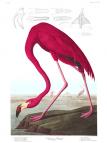 | Plate: 431 American Flamingo | ||
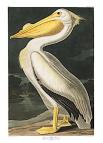 | Plate: 311 American White Pelican | ||
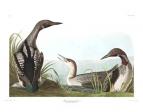 | Plate: 346 Black-throated Diver | ||
 | Plate: 307 Blue Crane or Heron | ||
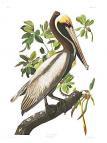 | Plate: 251 Brown Pelican | ||
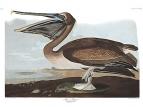 | Plate: 421 Brown Pelican | ||
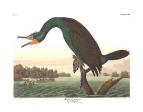 | Plate: 252 Florida Cormorant | ||
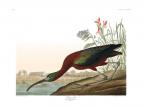 | Plate: 387 Glossy Ibis | ||
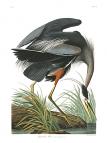 | Plate: 211 Great Blue Heron | ||
| |||

© Copyright 2007-2025 Zebra Publishing, LLC. | All Rights Reserved Terms of Use
Powered by Fusedog Media Group
